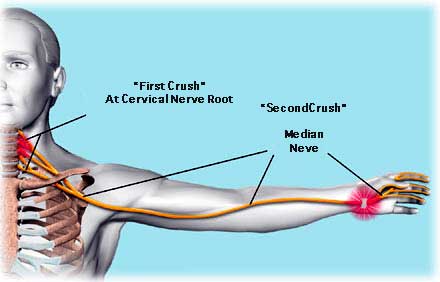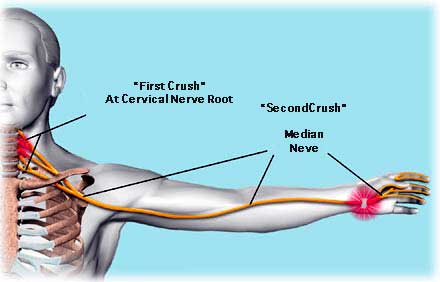CARPAL TUNNEL SYNDROME | Dr Alex Ritza | Downtown Toronto Chiropractor
By: Ben Walker of Your House Fitness & foreword by Dr Alex Ritza
Carpal tunnel syndrome is an interesting condition (like Tennis Elbow) because the core problem(s) that cause it are not at the site of the symptoms (collateral damage). Patients present with numbness and subsequent weakness in the thumb and first two fingers from the compression of nerves at the wrist and elsewhere, but often do not complain of anything else.

When you ask a few questions about their life and health they start to mention a host of other health problems and lifestyle habits that are less than perfect: neck pain, tension, headaches, excessive computer use, long work hours, hormone issues and often more chronic problems like diabetes and smoking.
While we often believe that the site of the symptoms is where the problem is, Carpal Tunnel Syndrome is a great example of why it is not. More on this later
A Comprehensive Approach To Managing Carpal Tunnel

By the time the symptoms have set in, there has been months, years or decades of compensation that have pushed the body towards its poor predicament. The biggest success in improving the symptoms associated with CTS come from addressing the nervous system and posture.
When the nerves and nervous system, especially those in the neck that travel to the hands are returned to a healthy state, symptoms begin to resolve. This is where I can help
When issues like posture, shoulder mobility, strength, diet, metabolism and core strength are addressed by people like those at Your House Fitness, the corrected functional and structural patterns that come from chiropractic care are solidified and improved upon.
CTS is a problem that almost never presents in those seeing me for ongoing chiropractic care or for those that have a proper training program. When all of the nerves, muscles, soft tissues and blood vessels above the wrist function properly there is less risk of a core problem, and this type of collateral damage is far less common.
What is Carpal Tunnel Syndrome?
Carpal Tunnel Syndrome (CTS) is a medical condition, where the median nerve becomes trapped and compressed at the wrist.
The nerve itself originates from the brachial plexus, a bundle of networking nerves, located above the clavicle region on each side of the neck. It’s the only nerve that travels through the carpal tunnel, hence the danger of it being pressed.
People who suffer from CTS will feel the pain systematically to where its present, but over time shooting towards its origin as the syndrome onsets and becomes worse. Therefore, pain in the arm will start travelling upward towards the cervical region.
Early Signs And Symptoms Of Carpal Tunnel
 The systematic pain around the wrist will mostly affect the muscular functions closest to the compressed nerve. The first complaint will be numbness and a sharp painful tingling sensation in the thumb, before feeling the same symptoms in the index and middle finger.
The systematic pain around the wrist will mostly affect the muscular functions closest to the compressed nerve. The first complaint will be numbness and a sharp painful tingling sensation in the thumb, before feeling the same symptoms in the index and middle finger.
There may be a further loss in motor function. Grip strength can be weakened due to the weakened receptors in the hand. You may feel restricted from grabbing something with force. A common indicator of CTS is experiencing extreme pain in the wrist while sleeping, which can often wake you up.
Associated Conditions
Neck Pain and Stiffness
Stiffness of the neck muscles and joints can put added stress and pressure onto the median nerve that eventually travels within the carpal tunnel. Compression of the median nerve at multple sites along its path to the wrist is common with this condition and essential to managing it properly
Diabetes
Carpal Tunnel syndrome is diagnosed in 27% of Diabetes patients in North America today. The effects of high blood pressure and increase in weight is said to play a role in making the canal for the carpal tunnel more narrow, adding extra compression to the median nerve.
Pregnancy
The build up of fluid (edema) in the limbs during pregnancy, causes swelling and applies pressure to the wrist.
Hypothyroidism
Thyroid Dysfunction causes fluid to be retained in the connective tissues in the body. The tissue overlying the wrist is affected by this swelling also.
Work Related
Many office and manual workers are diagnosed on a daily basis due to excessive motion or hyperextension that chronically wears down and compress the median nerve in the carpal tunnel. Hyperextension could be a result of poor wrist position when using a mouse, keyboard or typewriter.
Self Harm
As seen above, the causes of weight and high blood pressure play a major impact in CTS. Addictive habits such as smoking, drinking and eating can contribute significantly in causing carpal tunnel syndrome.
What you can do manage your CTS?
Improve your work setting
Make sure that you’re keyboard and chair are aligned properly for good posture and not hyperextending the wrist at all times. Keep your chair higher if possible and keyboard less inclines.
Keep healthy weight and blood pressure
Avoiding binge eating, smoking, drinking and other excessive habits.
This can help reduce the compression of the root canal over time, keeping BP reduced and avoiding the risk of diabetes that contributes to CTS.
Take breaks and practice good posture
Stress will also cause the compression to accelerate in the carpal tunnel. Take breaks, relax the shoulders more and practice good posture. This will also keep the brachial plexus functional and healthy from where it originates to the wrist.
Practice Your Grip
When holding items, try to use your hand opposed to just your fingers. This is important as a lot of the muscles supporting your wrist can become frail and weak.
Use your palm to grip to avoid imbalances.
Weight Training And Exercise
Carpal Tunnel Syndrome will develop in the wrist, and its primary symptoms offsetting from where the problem is localized. However, training the muscles from the upper traps/ cervical region to the hands will ensure that the muscles will stay strong, loosed and well balanced, helping the nerves travel well from the brachial plexus. This way the median nerve can operate healthy from its origin to the wrist. Cardiovascular exercise will keep your weight down also and be beneficial for avoiding CTS.
Don’t Promote A Thyroid Condition
Reduce Smoking
Increase Selenium Levels In Your Diet
Don’t over consume Soy products
BOTHERED BY CARPAL TUNNEL? OR HAVE RISK FACTORS THAT ARE PUTTING YOU AT RISK?





